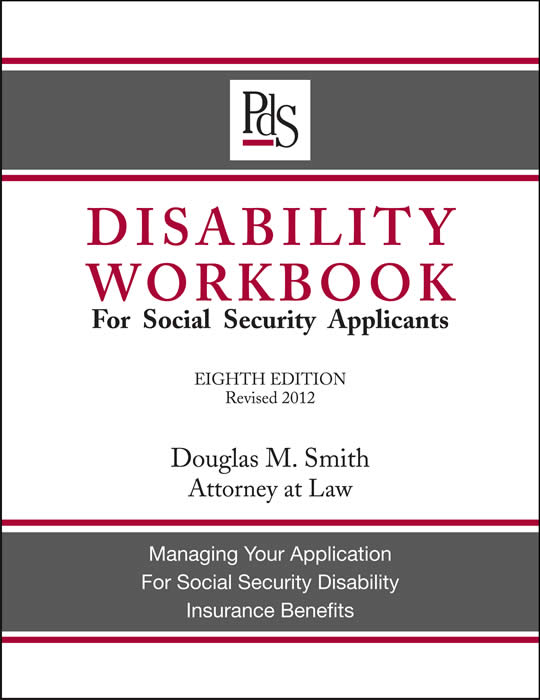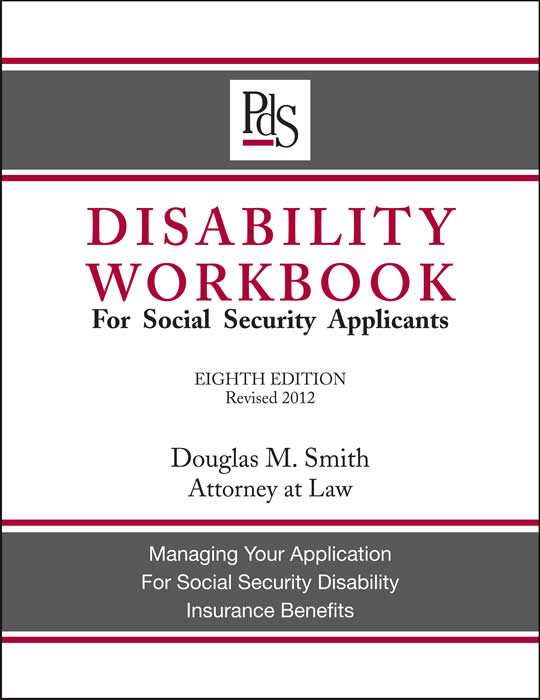SOCIAL SECURITY DISABILITY OUTLINE 2013
By Douglas M. Smith, Attorney at Law

We offer this outline to give a sense of the environment disabled Americans enter
when they draw upon their Social Security Disability Insurance (SSDI) benefits.
You may download a free Adobe® Acrobat® copy of the outline for personal use
Need Adobe® Acrobat® Reader software? Download it free at Adobe.com
I. TWO DISABILITY PROGRAMS: SSDI & SSI
A. SOCIAL SECURITY DISABILITY INSURANCE (SSDI)
Social Security Disability Insurance (SSDI) pays benefits
to over 10 million Americans.
If you are disabled and have had FICA tax withheld from your paycheck, you may qualify for SSDI benefits. Here are some questions and answers that may help you.
o When does payment of my SSDI cash benefit begin? It starts the 6th full month after your disability begins.
o How much will my benefit be? The amount of your cash benefit varies according to your past earnings.
o When will I start getting Medicare? Medicare starts 24 mos. after date of entitlement to the first monthly SSDI check. This may leave a health insurance gap for you.
Try filling the gap with paid sick leave, spouse’s insurance, unpaid Family Medical Leave Act time, COBRA, state health plans, etc.) For more information, on the Internet see:
COBRA (Source - U.S. Dept. of Labor) http://www.dol.gov/dol/topic/health-plans/cobra.htm
Family and Medical Leave Act (Source - U.S. Dept. of Labor)
http://www.dol.gov/dol/topic/benefits-leave/fmla.htm
o I receive Social Security retirement checks; I’ve developed a disability. Can I receive an SSDI disability benefit as well as my retirement benefit? To receive Social Security Disability Insurance (SSDI) benefits you must be younger than the Social Security retirement age. Therefore, if you already receive Social Security retirement benefits you generally cannot receive SSDI.
o How is Social Security Disability Insurance paid for? How do I know whether I am insured for SSDI? Employers withhold "FICA" tax from the paychecks of most workers. Employers pay a share of the FICA tax as well. Part of the FICA tax is applied to the premium for SSDI. You must have earned a certain number of “work credits” to receive SSDI.
The Social Security Administration (SSA) explains: “When you work and pay Social Security taxes, you earn up to a maximum of four "credits" for each year. . .
“The number of work credits needed for disability benefits depends on your age when you become disabled. Generally you need 40 credits, 20 of which were earned in the last 10 years ending with the year you become disabled. However, younger workers may qualify with fewer credits.” For more information go to http:/www.socialsecurity.gov/retire2/credits3.htm
“Credits are . . . based on your total wages and self-employment income during the year, no matter when you did the actual work. You might work all year to earn four credits, or you might earn enough for all four in a much shorter length of time.
“In the year 2013, you must earn $1,160 in covered earnings to get one Social Security or Medicare work credit and $4,640 to get the maximum four credits for the year.” http://www.socialsecurity.gov/retire2/credits1.htm
To assure that you have enough work credits (and that your earnings record is correct) get a "Social Security Statement of Earnings and Benefits." Social Security may be mailing you one already. If not, you can see your earnings record and get an estimate of benefits online at http://www.socialsecurity.gov/myaccount/. Or call 800-772-1213 or visit your Social Security office.
o What should I take with me when I apply for SSDI? For more complete instructions, go to: http://www.socialsecurity.gov/dibplan/dapply.htm
Birth and marriage records are part of what you should take to the Social Security Administration. If you lack these records, you may learn how to obtain birth, death, marriage or divorce certificates on the Internet:
http://travel.state.gov/birthcertificaterequest.html
http://www.cdc.gov/nchs/howto/w2w/w2welcom.htm
Take your Social Security number. If your card is lost, you may ask for a duplicate Social Security card. To learn how call 1-800-772-1213
B. SUPPLEMENTAL SECURITY INCOME (SSI)
Cash, Medicaid for more than 8 million Americans
We mention SSI AND MEDICAID because some SSDI beneficiaries with little income and few assets get SSI and Medicaid too. Ask your local Social Security office.
In 2013, the federal SSI benefit is $710 a month for an individual; $1,066 a month for couples who both qualify, plus immediate Medicaid. http://www.ssa.gov/pressoffice/factsheets/colafacts2013.htm
Some states add state benefit to the federal SSI benefit. http://www.socialsecurity.gov/ssi/text-benefits-ussi.htm
Medical proof of disability is the same for SSDI and SSI.
II. YOU MUST PROVE YOUR DISABILITY
A. You have the legal burden of proof.
"An individual shall not be considered to be under a disability unless he furnishes such medical and other evidence of the existence thereof as the Commissioner of Social Security may require." Social Security Act, Sec. 223(d)(5)(A)
B. Know the SSA definition of disability.
o You must be unable to do substantial gainful activity - that is, you must be unable to work regularly and must not be working and earning over $1,040 a month in 2013 (People disabled by blindness can earn $1,740 per month in 2013).
o Due to one or more medically determinable physical/mental impairments;
o That are expected to result in death; or have lasted or are expected to last at least 12 months. Social Security Act, Section 223(d)(1)(A)
C. Practical hints for proving your claim
1. Get information before filling out SSA forms:
o List your impairments (diagnosed conditions and how they limit you)
o List doctors and hospitals caring for you
o Describe your medications/therapy
o Describe daily living activities -- what you do/don't do, what others do for you
o Describe jobs of the past 15 years – especially their physical & mental demands
o Get a written report from your doctor
2. Apply promptly;
3. Apply in person if possible;
4. Write things down; keep copies;
5. Monitor the progress of your claim through your SSA office or DDS
6. Appeal any unfavorable decisions--if you and your doctor believe you are disabled.*
* Need an experienced disability lawyer? Try the National Organization of Social Security Claimants' Representatives ("NOSSCR"), phone 800-431-2804. NOSSCR has over 2,000 members, mostly lawyers.
D. Social Security Disability forms commonly used
Disability Report, Form SSA-3368-BK http://www.ssa.gov/online/ssa-3368.pdf
Work History Report, Form SSA-3369-BK http://www.ssa.gov/online/ssa-3369.pdf
Function Report, Form SSA-3373-BK http://www.ssa.gov/online/ssa-3373.pdf
For discussion of how best to fill out these forms, see the Disability Workbook for Social Security Applicants
III. AFTER AWARD, DISABILITY REVIEWS
The Notice of Award of benefits you receive when SSA approves your disability claim specifies approximately when you can expect SSA to review your disability status.
Under Social Security law, all disability cases must be reviewed from time to time. This is to assure that people receiving benefits continue to be disabled and meet all other requirements.
A. What is the purpose of a continuing disability review?
The purpose of a continuing disability review (or “CDR”) is to decide whether an individual has ceased to be entitled to disability benefits because:
1. the physical and/or mental impairment has ceased,
2. does not exist, or
3. is not disabling.
Social Security Act, Section 223(f)
B. When can you be reviewed?
You may be reviewed:
o At any time if your review is due or overdue;
o Any time you have worked and earned at or above the amount SSA calls "substantial gainful activity” or “SGA" for a total of nine months. This doesn't have to be nine consecutive months. You would be earning SGA in 2013 if you worked and earned an average of $1,040 a month or more, or if legally blind $1,740 per month or more.
o Six to 18 months after award if medical improvement can be predicted at the time benefits start;
o About every three years if medical improvement is possible but cannot be predicted; or
o About once every five to seven years if medical improvement is unlikely.
See Social Security: What You Need To Know When You Get Disability Benefits (SSA Pub. 05-10153).
C. How will SSA notify you?
Most people will receive one of two kinds of review:
Full Medical Review. When SSA wants a full medical review they send you a letter announcing the review, and someone from your Social Security office contacts you. They ask you to provide information on Form SSA-454-BK about any medical treatment you've received and any work you have done. SSA generally wants information about your medical and hospital visits in the past 12 months, including copies of records. You may be asked to come to the SSA office without much notice -- seven days notice isn’t uncommon. Ask for more time if you need it.
Mailer Review. Some people receive a Disability Update Report (Form SSA-455 or Form SSA-455-OCR) in the mail, and are asked to fill it out, and return it to SSA. These usually are people whom SSA considers unlikely to have their benefits terminated. Most people who receive mailers do not undergo full medical review unless their responses indicate possible medical improvement or increased work capacity. A few people have both mailer and full medical reviews.
D. How do you respond?
Consult your doctor before responding to a notice of review. In a mailer review you need only answer a few questions and return the mailer, but despite the apparent simplicity of the process it is wise to talk with your doctor about the questions before answering because some involve medical conclusions. In a full medical review you should provide substantial medical evidence showing that you continue to be incapable of sustained work on a regular basis, and this necessarily involves input from your doctor.
E. What percentage of people reviewed, are terminated?
Relatively few people have benefits terminated for medical reasons. SSDI benefits ended for 653,877 workers in FY 2011 due to all causes (including transition to Social Security retirement benefits, death, resuming work, medical improvement). Only 3.6% of these benefit terminations resulted from the beneficiary's medical improvement according to The Social Security Green Book, 2012. *
* U.S. House of Representatives, Committee on Ways & Means, CRS Primer on Disability Benefits: Social Security Disability Insurance (SSDI) and Supplemental Security Income (SSI), Table I, page 4.
F. If SSA stops your benefits, what should you do?
If SSA proposes to stop your benefits, you have a valuable right of appeal.
o Appeal if you and your doctor believe you are unable to work on a sustained regular basis.
o If you want your benefits to keep coming while you appeal, elect continuation of benefits in writing within ten (10) days after your termination notice. Probably it’s best to both elect benefit continuation and file your appeal within 10 days.
G. Should you do anything now, before being reviewed?
See your doctor regularly. Ask your doctor at least annually whether or not you are well enough to do full time competitive work. Keep copies of all records of medical or hospital care or tests; especially care or tests received since your last SSA disability award or disability review decision.
Conclusion. CDRs are nothing to dread. They are routine inquiries by the government to assure that people receiving disability benefits continue to be disabled. If a beneficiary remains medically unable to work, he or she will keep the benefits without interruption. If SSA should err, and try to terminate benefits, the prospects for reversing the erroneous decision through an appeal are very good.
Updated May 23, 2013

Disability Workbook for Social Security Applicants
Copyright 2013, all rights reserved, Douglas M. Smith, Pds-Third Floor Publishing, LLC,
4848 Lemmon Avenue, Suite 100, Dallas, TX 75219
This outline may be reproduced for your personal use, but you may not delete or change any part of it including this copyright notice. To request permission to edit or distribute it contact, Pds-Third Floor Publishing, LLC, at the address above, or email at dfacts@earthlink.net
|
![[Free Resources]](../images/resources.gif)
![[Free Resources]](../images/resources.gif)